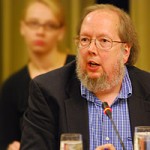by Terry Mattingly
 As we are well into our 30(40) Days of Blogging, I feel this article by Terry Mattingly (tmatt.net) is especially important. For years, I have suggested that specific and intentional blogging can make one a better preacher. I’ve also suggested, sometimes firmly, to any bishop interested in listening pretty much what is in this article. We are looking at a new vehicle and form of pastoral ministry. This is very important, and should not be dismissed by those who don’t know what we are talking about. Please – just ask!
As we are well into our 30(40) Days of Blogging, I feel this article by Terry Mattingly (tmatt.net) is especially important. For years, I have suggested that specific and intentional blogging can make one a better preacher. I’ve also suggested, sometimes firmly, to any bishop interested in listening pretty much what is in this article. We are looking at a new vehicle and form of pastoral ministry. This is very important, and should not be dismissed by those who don’t know what we are talking about. Please – just ask!
The bottom line is this: If you want people to stay connected with the living Church, then you have to connect with your people in the ways they seek connection.
Bloggers, preachers and priests: Heed what you learn after reading this article, and I encourage you to comment freely.
As every avid Twitter user knows, there are only 140 characters in a “tweet” and that includes the empty spaces.
The bishops gathered at the ancient Council of Nicea didn’t face that kind of communications challenge and, thus, produced an old-fashioned creed that in English is at least 1,161 characters long.
No wonder so many of the gray-haired administrators in black suits in the U.S. Conference of Catholic Bishops struggle with life online. It’s hard to take seriously the frivolous-sounding words — “blog” and “tweet” leap to mind — that define reality among the natives on what Pope Benedict XVI calls the “Digital Continent.”
“In the past, the church would often build new parish structures, knowing that people would recognize the church architecture and start showing up. On the Digital Continent, ‘If you build it, they will come’ does not hold true,”
said Bishop Ronald Herzog of Alexandria, La., in a report from the body’s communications committee.
“We digital immigrants need lessons on the digital culture, just as we expect missionaries to learn the cultures of the people they are evangelizing. We have to be enculturated. It’s more than just learning how to create a Facebook account.”
This is important news in an era in which recent research from the Pew Forum on Religion & Public Life found that the Catholic Church was retaining 68 percent of its members who, as children, were raised in the fold. While the church is making converts, those who have left Catholicism in recent years outnumber those who have joined by nearly a 4-to-1 ratio.
Almost half of those who left Catholicism and did not join another church exited before the age of 18, as did one-third of those who chose to join another church. Another 30 percent of young Catholics left the church by the age of 24. At that point, the departure rate slowed down.
Truth is, it is almost impossible to talk about the lives of teens and young adults without discussion the growing power of their social-media networks. For young people worldwide, social media and their mobile devices have become the “first point of reference” in daily life, warned Herzog.
“The implications of that for a church which is struggling to get those same young people to enter our churches on Sunday are staggering. If the church is not on their mobile device, it doesn’t exist.”
As recently as a similar report in 2007, it was clear the bishops were hesitant to discuss the digital world because they feared its power when used by the church’s critics, said Rocco Palmo, who produces the influential “Whispers in the Loggia” weblog about Catholic news and trends.
The Herzog report was a step forward, primarily because the bishops seem to realize this is a subject that they cannot ignore. That’s significant in an era in which many Vatican officials still cling to their fax machines and struggle to keep up with their email. During the recent Baltimore meetings, said Palmo, there were more iPads in the hands of younger bishops “than you would find at your local Apple store.”
“In the old days, that stone church on the corner was a sign of the presence of God in your community. Well, that’s what a church website is today,” he said. If bishops and priests cannot grasp “that one-dimensional reality in our culture, how are they supposed to grasp the two-dimensional, interactive world of social media?”
The theoretical stakes are high, noted Herzog, but it has also become impossible to ignore the raw numbers. For example, if the 500 million active Facebook users became their own nation, it would be the world’s third largest — behind China and India.
The bottom line: Catholicism may be
“facing as great a challenge as that of the Protestant Reformation,” said the bishop.
“Anyone can create a blog. Everyone’s opinion is valid. And if a question or contradiction is posted, the digital natives expect a response and something resembling a conversation,” said Herzog. “We can choose not to enter into that cultural mindset, but we do so at great peril to the Church’s credibility and approachability in the minds of the natives. …
“This is a new form of pastoral ministry. It may not be the platform we were seeking, but it is an opportunity of such magnitude that we should consider carefully the consequences of disregarding it.”
